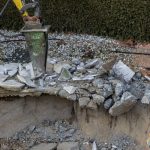How to Lower Your Basement Floor
When expanding a building, there are 3 ways you can go: up, out or down!
The third option is very popular with homeowners who have a house with a crawl space or shallow basement. Lowering your basement floor is a way to expand your house, increase its value and make the most out of the space.
That being said, converting a cramped, dark space into a comfortable basement is a complicated project that can pose certain risks, so it’s best to have it done by specialists.
In this article, find out how excavation professionals dig out a crawl space or shallow basement to expand a home.
Check the project’s feasibility before starting the excavation
As mentioned above, lowering a basement floor is a major undertaking. There are a variety of obstacles that can threaten the viability of the project.
Before starting the excavation, there are several factors you should check and take into consideration:
Type of soil
Whether a house is built on clay soil or solid rock, there are usually solutions for excavating a basement.
If the ground is made up of sand or clay, it may be necessary to support the new foundation with piles driven into the rock to prevent the structure from destabilizing in the event of soil subsidence caused by drought.
If the ground is solid rock, specialized excavation equipment will be needed to break through it.
One thing’s for sure—you’ll need to know what type of soil you’re dealing with in order to properly plan your basement excavation.
Plumbing and sewer system
The feasibility of your basement expansion and renovation project may also depend on the layout of the plumbing and sewer system. Workarounds such as moving pipes can always be found, but they sometimes end up costing more and reducing the available space.
For example, if you need to excavate past the level of the French drain pipes, you’ll need to create a catch basin and install a pump to divert water away from the house.
And if the project includes adding a bathroom to the basement, you will also need to install a pump to evacuate wastewater and direct it to the municipal sewer or septic tank.
Municipal regulations and the National Building Code
Like any residential construction or demolition project, a permit is required before work can begin. Municipalities usually require several documents in order to issue a permit for a basement excavation:
- A structure plan made by an engineer
- A plan for the interior made by an architect or technologist
- A contract with the excavation contractor you selected
- A certificate of location
It’s also important to note that the National Building Code has strict requirements about the minimum amount of natural lighting in certain rooms. The dimensions of a bedroom window must be equivalent to at least 5% of the room’s area. The requirement increases to 10% for dining and living rooms.
Budget
The price of a lowering a basement floor has so many variables that it is very difficult to estimate without an in-depth knowledge of the project in question.
The cost will vary depending on the current basement layout, the depth of the excavation, the amount of concrete that needs to be added or replaced, and whether or not any rock is involved.
In some situations, the cost can climb so high that homeowners may decide to find a different way to expand their home.
The two methods of basement lowering
Once the project has been given the green light, the residential excavation contractor will bring the necessary equipment to the worksite.
There are two ways to lower a basement floor. Regardless of which method is chosen, it’s important to make sure that the building is well-supported both during and after the work.
Bench footing
In most residential buildings, 15 to 30 cm of additional clearance can be achieved by simply lowering the existing concrete floor. Bench footing is less expensive than underpinning, but doesn’t always produce the desired ceiling height.
To lower a concrete floor without causing subsidence, it’s important to avoid shifting the soil near the bottom of the foundation walls. The excavation contractor will dig out the centre of the basement, then pour concrete around the perimeter at a 45-degree angle between the new floor and the bottom of the foundation.
Underpinning
Generally, the only way to obtain a ceiling at least 8 ft (244 cm) high is underpinning. This involves pouring a new concrete foundation underneath the existing one.
The contractor starts by excavating the centre of the basement, making sure that the beams and other structural elements of the building are supported in order to maintain its stability.
They will then dig holes in a few places underneath the existing foundation walls to install metal posts and pour foundation sections approximately 140 cm wide.
The rest of the new foundation will be excavated and poured, section by section. Of course, the process requires several precautions to prevent the soil from shifting under the old foundation.
Basement excavation for semi-detached houses
Even if a house has party walls, as is often the case in Montreal, its crawl space can still be converted into a proper basement.
Regardless of whether they are stone or concrete, the party walls are generally kept intact to minimize the effects of the excavation on the adjoining buildings.
The front and rear foundation walls are usually completely redone. That makes it much easier to create larger windows and install a membrane and a French drain to waterproof the foundation from the outside.
A 2.5 m wide portion of a front or back wall will always need to be removed to provide an entry point for the excavation equipment.
Want to lower your basement? Call on our excavation services!
Lowering a basement floor requires careful planning, extensive expertise and specialized equipment. It’s a project that should not be undertaken by amateurs.
If you want to expand your crawl space or shallow basement, leave it to an excavation company in Montreal or elsewhere in Quebec. At Excavation Chanthier, we work with engineers and structure and foundation specialists to carry out successful basement excavations.
Contact us today to find out more about our services!







